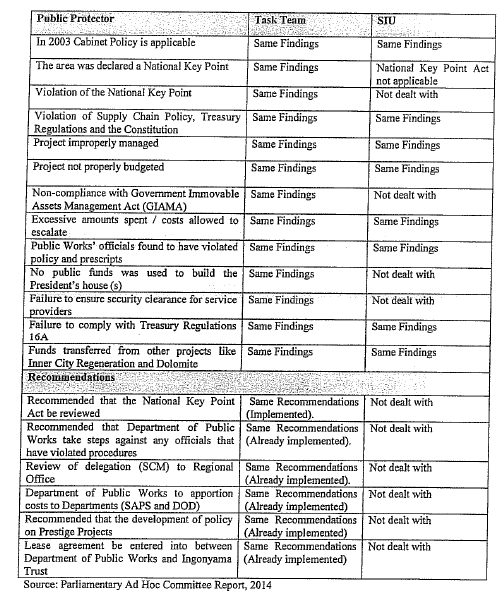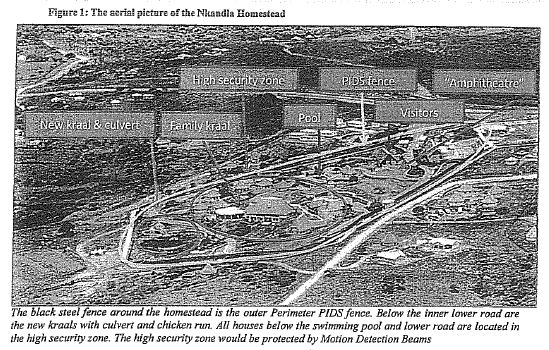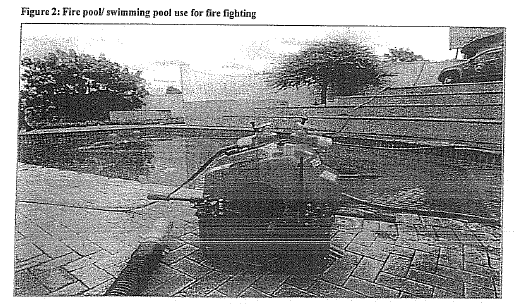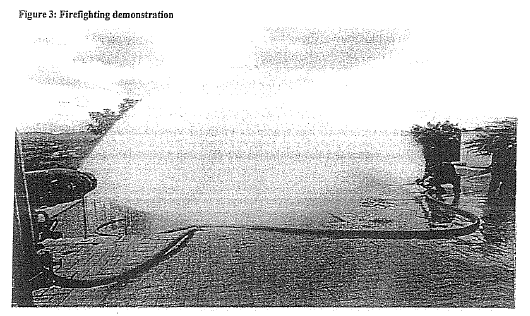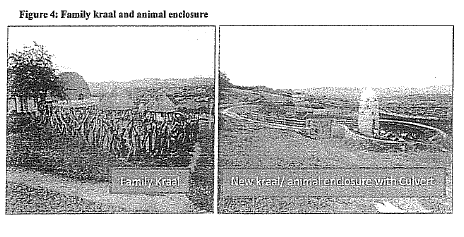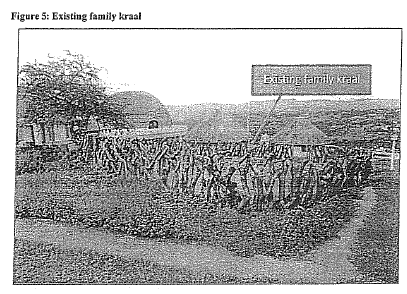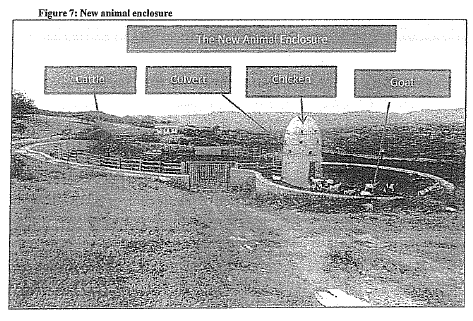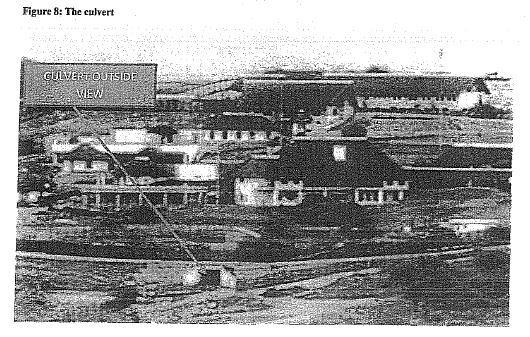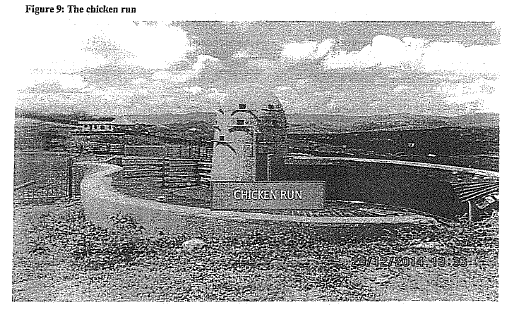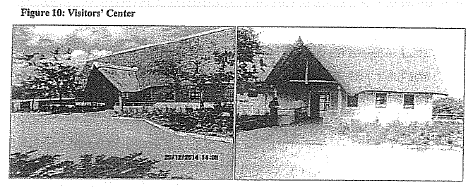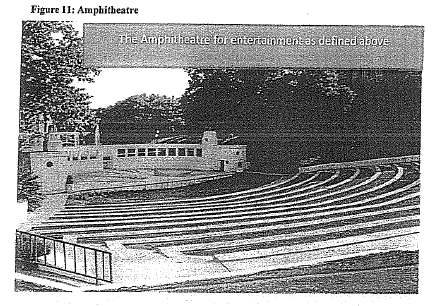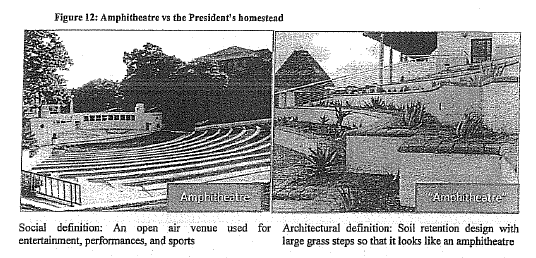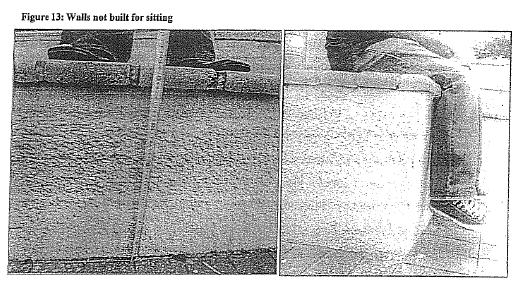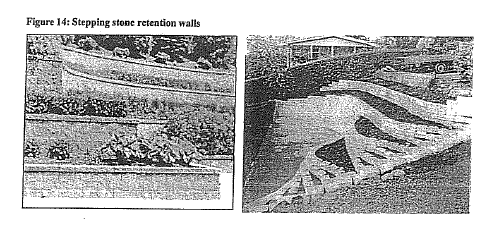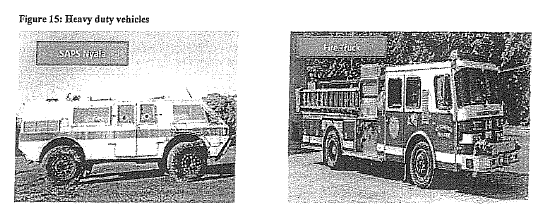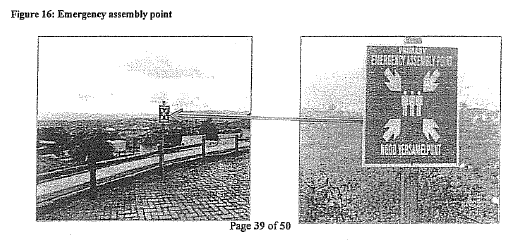REPORT BY THE MINISTER OF POLICE TO PARLIAMENT ON
SECURITY UPGRADES AT THE NKANDLA PRIVATE RESIDENCE OF THE PRESIDENT
25 March 2015
ACKNOWLEDGEMENTS
I wish to acknowledge and thank:
- The Minister of Public Works for the invaluable contribution that he made by volunteering relevant documents in this regard;
- The Reference Group and its Members, in particular the security experts therein, who provided incisive investigative analysis pertaining to this work;
- We are also appreciative of the contributions of the frre officer of iNkandla Municipality, Mr Ntombela and Chief Fire Officer of uMhlathuze Municipality, Mr. Vumba; cultural expert, Professor Ntshangase; the advising architect, Mr. Mhlaba; the PIDS technician, Mr. Mlawulo; as well as the advising engineer, Mr. Cyril Gamede;
- The President of the Republic of South Africa for his cooperation and for providing access to his homestead; and
- The Acting Secretary of Police for providing technical, administrative and logistical support to this work.
ABBREVIATIONS
DPW - Department of Public Works
DOD - Department of Defence
MDB - Motion Detection Beams
PID - Perimeter Intrusion Detection
SANDF - South African National Defence Force
SAPS - South African Police Service
SCM - Supply Chain Management
SIU - Special Investigations Unit
SSA - State Security Agency
PREFACE
The security upgrades in the Presidential Homestead in Nkandla has dominated public discourse since November 2011 when the matter first appeared in the Mail and Guardian. It gained momentum after formal complaints were lodged with the Public Protector, first in December 2011 and then in late 2012 after a further newspaper article appeared in the City Press.
The origins and positioning of this discourse are important, as they reflect the mind-sets and cultural orientation that inform the interpretation of the nature and the validity of the upgrades that were effected at the Presidential Homestead in Nkandla.
Taking into account, the magnitude and intensity of scrutiny that the security upgrades at the Nkandla Private Residence of the President have been subjected to, the scope of this report is confined to the mandate given to the Minister of Police by Parliament through the 'Ad Hoc Committee to consider the Report by the President regarding the security upgrades at the Nkandla private residence of the President'.
1. INTRODUCTION
1.1 The President, His Excellency Mr Jacob Zuma, in his report to the National Assembly regarding the security upgrades on 14 August 2014 stated that, "I deem the following to be appropriate: The Minister of Police as the implementing Minister under the National Key Point Act, to expedite the review of this legislation which is currently under way and to report to Cabinet periodically of the progress in this regard; and the Minister of Police as the designated Minister under the National Key Points Act, to report to Cabinet on a determination to whether the President is liable for any contribution in respect of the security upgrades having regard to the legislation, past practices, culture and findings contained in the respective reports".
1.2 The report also responds to recommendation 5.9 arising from the 'Ad Hoc Committee to consider the Report by the President regarding the security upgrades at the Nkandla private residence of the President' adopted by the National Assembly on 11 November 2014 relating to "what constitutes security and non-security upgrades", as expressed in correspondence from the Speaker of the National Assembly to the Minister of Police, dated 29 December 2014.
1.4 A brief report was submitted to the Speaker of the National Assembly in February 2015 in response to the recommendations as expressed below:
1.4.1 Establishing a technical team of qualified security experts to undertake an evaluation of the existing security features at Nkandla, its effectiveness, and its appropriateness in relation to the Special Investigation Unit (Sill) report; to which the Minister of Police indicated that, a report will be presented before Parliament by the end of March 2015.
1.4.2 Assessing the policy and regulatory gaps relating to securing the private residences of political office bearers; in this regard the Minister of Police stated that the Civilian Secretariat for Police has undertaken a comprehensive review of all policies, legislation (including the National Key Points Act, Act 102 of 1980), regulations, and court judgments pertaining to the national key points. The outcomes of this review highlighted the need for a National Critical Infrastructure Protection Policy. The Policy is currently before Cabinet and will be introduced to Parliament after the Cabinet process has been completed.
1.4.3 A comprehensive review of the National Key Points Act, Act 102 of 1980; in response the Minister of Police stated that the process of reviewing the Act commenced in 2008. Given that conditions had changed significantly since 1980, and a number of policy gaps were detected, it was decided that a National Critical Infrastructure Protection Bill be developed in line with the National Critical Infrastructure Protection Policy, which will seek to repeal the National Key Points Act. The National Critical Infrastructure Protection Bill, which is curre11tly within the Cabinet process, will be published in the Government Gazette, alongside the release of the National Critical Infrastructure Protection Policy, for public comment.
1.5 This report that is tabled before Parliament today is focused on the alleged non security features. The Public Protector had examined all complaints related to the security upgrades of the President's private residence in Nkandla, and has confirmed that no public funds were used to upgrade the private residence of the President, with the exception of specific features which were listed as questionable, namely the swimming pool, new kraal, visitors' centre and the amphitheatre. This report presents a careful analysis of each of the features and its purposes, as well as the context that informed its construction. I believe that my recommendation in respect of a determination, as assigned by Parliament, will assist in amicably concluding this matter.
2. PURPOSE
2.1 The purpose of this report is to inform Parliament of the outcomes of the assessment of the security features in Nkandla, the private residence of the President, with specific reference to features that the Public Protector's Report refers to as 'non-security'. (Public Protector's Report 2014, page 431 par I 0.5.1. & page 432; par 10.5.4.).
2.2 This report further determines whether the President is liable for any contribution in respect of the security upgrades.
2.3 In responding to the finding of the Public Protector in relation to non-security features, this report further honours the determination by the 'Ad Hoc Committee to consider the Report by the President regarding the security upgrades at the Nkandla private residence of the President' that, " ...it would be premature for the committee lo make a finding of undue enrichment prior lo the matter having been attended to by the relevant security practitioners consistently with the Cabinet Memorandum of 2003 ". (Parliament of RSA: Announcements, Tabling's and Committee Reports; 11 November 2014; page 2978, par 4.25. Adhoc Parliamentary Committee: Nkandla security upgrades).
3. BACKGROUND
3.1 The President in his report to Parliament on 14 August 2014 directed the Minister of Police to, among others, make a determination regarding his financial liability in relation to the findings of the Public Protector. The request was followed up by further correspondence from the Speaker of the National Assembly on the 29th December 2014 pertaining to security upgrades at the Nkandla private residence of the President, requesting that the Minister attends to the recommendations of the Parliamentary Ad Hoc Committee.
3.2 There have been various investigative reports undertaken regarding this matter, all of which were considered when developing this report. These include:
- Investigation Report Prestige Project 'A': Security Measures President's Private Residence; Nkandla. The Department of Public Works (Task Team). 28 January 2013
- The Inter-Ministerial Security Cluster Task Team Report. 19 December 2013
- Secure in Comfort. The Public Protector. 19 March 2014
- Report to the Speaker of the National Assembly regarding the Security Upgrade at the Nkandla Private Residence of his Excellency, President Jacob Zuma. The Presidency. 14 August 2014
- The Special Investigation Unit Final Report to the President of the Republic of South Africa, his Excellency, President Jacob Zuma. Special Investigating Unit (SIU). 20 August 2014
- Report of the Ad hoc Committee to consider the Report by the President regarding the Security Upgrades at the Nkandla Private Residence of the President. National Parliament. 11 November 2014
3.3 It should be noted that a number of investigations and subsequent reports have been generated around the security upgrades at the Nkandla Private Residence of the President, amongst which are listed above.
It should further be noted that going through these reports by different investigative arms of government there are a number of points of convergence that emerge. Here under is the summation of points of convergence:
Table 1
3.4 Clearly the above table indicates that there is no dispute amongst the Public Protector, the DPW Task Team, the SIU, and the Parliamentary Ad hoc Committee Reports that the security upgrades undertaken in the private residence of the State President were necessary. All parties accept that DPW and the security entities were within their mandates, as well as the Constitutional obligation to do so.
3.5 Of specific relevance is the finding by the Public Protector in her report on Nkandla security upgrades that among others, "President .J.G. Zuma improperly benefited from the measures implemented in the name of security which include non-security comforts such as the Visitors' center, Swimming pool, Amphitheatre, Cattle Kraal with culvert and Chicken run." (Public Protector's Report, 2014 page 431; par 10.5.3.)
3.6 The picture below depicts the layout of the entire private residence of the President in Nkandla from an aerial point of view. This aerial view shows the high security zone in red, the outer perimeter fence in yellow, and the blue points to the actual location of the features in dispute.
3.7 It is apparent from various reports that the Nkandla 'prestige project' cost the state in the region of R2 I 6 Million according to Special Investigation Unit. (SIU report page I par I dated 24 August 2014).
3.8 The Department of Public Works documents show that the above amount as at December 2012 was confirmed to be at R206 420 644.28 (SIU 2014:31 para 111). According to the Chief Financial Officer (CFO) of Public Works memorandum dated November 2012, this amount was divided into two. The first portion is the cost of the security features which amounted to R71 212 621.77 including consultancy and/ or professional fees. The remainder of R l35 208 022.51 was the cost of departmental operational needs, such as the clinic, SAPS and SANDF staff quarters and needs, and consultancy fees amongst others.
3.9 Consultancy and/or professional fees amounted to R20 688 736.89. Therefore the total for security features excluding the consultancy and/or professional fees is RSO 523 884.88 (page 31, par 112 and 114 of the Department of Public Works Investigation Report, 2014). It appears from the Public Works document that an amount of Rl O million was expected to be paid by the President for what was referred to as private expenses. This amount of Rl O million was further reduced to an amount of R3 million and no reasonable and clear explanation was given for how this amount was determined and what led to the reduction.
3.10 Page 207 of the same SIU report under the heading 'Civil Claims', under claim B par 6, states that "after his appointment, Makhanya proceeded to authorize and oversee the implementation of improvements and the installation of security measures at Nkandla in excess of and beyond the security assessments and requirements that had been determined by SAPS and SANDF, and at a cost far more than that was approved and budgeted for by DPW". It further states that Ibhongo consultants, who provided civil and structural advice, were paid a total of R6 006 497.36. However, this was R255 681.51 more than they should have been paid, according to SIU Report, 2014 page 211, para 30.
3.1 1 The SIU report acknowledges that "On 28 May 2009 the SAPS visited Nkandla to conduct their first assessment after Mr. Zuma had become President. The SAPS then prepared a farther assessment report. The report does not mention costs. This is unsuprising as the upgrades were to be implemented by the DPW, which would also bear the costs of the upgrades, save for those specific to the accommodation requirements of the SAPS personnel .... ". This assessment report was handed over to the DPW's acting DG on 9 June 2009 (SIU report dated 20 August 2014, page 70; par21).
3.12 The Prestige Project was conducted as a high security project. The SIU report page 28 par 61 suggests that the minutes of meetings held relevant to this project could not be located and the SIU was informed that the meetings were classified as 'Special Meetings' and there were no recordings. These meetings, convened by DPW, were attended by private contractors and/or consultants and officials from the following government departments, namely SAPS, DoD and SSA.
3.13 The adjustments were allegedly presented in subsequent meetings where they would have been approved by various stakeholders present. The one version is that in those meetings further requests for adjusting the scope were received from Departments or security agencies. The other version from the SAPS, represented by Brig Adendorff, is that "DPW held weekly site meetings during which designs changes were discussed and/or made ....by theprivate professionals" (SIU report page I 71 par 79).
3.14 The facts as contained in the Department of Public Works Investigation Report, 2014, page 34; par 123 thereof, state that the following contractors did not go through security clearance process as was a prereq uisite, namely;
- CA Du Toit (Security),
- Ibhongo Consultants (Civil/Structural Engineers),
- Ilangalethu Consulting (Quantity Surveyor),
- Minenhle Makhanya Architects (Principal Agent/Architectural Design),
- Mustapha and Cachalia CC(Mechanical Engineer),
- IGODA (Electrical) and
- E Magubane Information Systems (Electronic Detection System).
These contractors were limited in terms of understanding explicitly the end users intention and purpose and were therefore not equipped to make a determination on what constituted private and public costs.
3.15 This argument is supported by Mr. Makhanya, of Minenhle Makhanya Architects, who conceded that he and his team of experts comprised of architects and engineers were not vetted and did not have security clearance, though they were cautioned about the sensitivities of the project. Accordingly, they were not allowed to keep any documents related to the project.
3.16 Mr. Makhanya, who is among the persons who was approached to do cost determination, stated that he as an architect is not trained to determine how the President benefits from the government sponsored security measures and he believes his engineering team is also not competent in that field, however they tried to deliver what the client, the Department of Public Works, wanted from them. There was no measuring instrument and /or legal bases used to make this determination according to Mr. Makhanya.
3.17 Furthermore, the lack of security clearance also meant that the end-user design and use of certain facilities or areas could not be divulged to the Makhanya team, and hence their architectural plans named facilities differently to those of the security objectives. Basically, they had to design and build certain structures and technicians from the South African Police Service (SAPS) or the State Security Agency (SSA) and the South African National Defence Force (SANDF) would thereafter come to install their equipment and reconfigure where necessary. This made project management and project coordination difficult and introduced its own set of complications.
3.18 Cost determination could not have been informed by the National Key Points Act, Act No. !02 of 1980 as it is not applicable in this particular instance. What is applicable is the Cabinet memorandum dated 20 August 2003, which caters for the security interests of the President, Deputy President and Fonner Presidents & Deputies. It should be further noted that in line with international best practice, the Cabinet Memorandum does not place a cap on the costs to be spent on the protection of the above VIPs.
3.1 9 Furthermore, the Ministerial hand book is also not applicable in this case as i t only provides guidelines for benefits and privileges to which Members of the Executive and their families are entitled to in the execution of their duties. By its very nature and character, the Ministerial Handbook excludes the President, Deputy President and Former Presidents & Deputies.
3.20 The Department of Public Works Investigation Report, 2014, page 29 par 104, states that "....it is evident from the terms of the Cabinet decision and policy approved that the main consideration was the safety of the President. It isfarther clear that the decision does not place any limit on the amount to be spent on the security upgrades to the residences of sitting Presidents and Deputy Presidents as well as theirpredecessors ... "
3.21 Chapter Five of the SIU Report makes reference to various features built in Nkandla that are said to have been inflated in cost price and extended in scope, without explicit and necessary approval of the Departments concerned. In particular page 140, SIU report; par 45 states that "in addition, Makhanya designed and authorised the construction of the 175klfire pool . ...the total amount paid for the fire pool and VIP parking’s was R 3 964 239" is noted and the fire pool shall be dealt with in context here-under.
3.22 Of relevance to the above point is Page 7 ·of the Department of Public Works Investigation Report, par. 23 & 24, which states that "...on 21 May 2009, the professionals of DPW visited the President's residence and prepared a scope or proposal on security upgrades to be effected at the residence. According to the initial scope by Public Works, the estimated cost was approximately R27 million ... it should be noted that the initial scope and proposal has no input from the South African Police, Department of Defense or National Intelligence Agency ... ".
3.23 The Department of Public Works proposals on security upgrades with the heading "Durban Project A: site visit" dated 21 May 2009, Annexure B referred to above and observed that the unnumbered 3rd page of this report, under the topic "Architectural", contains a list of proposed upgrades. One of the upgrades that appear under letter 'F' is a "Proposed swimming pool to be used as a reserve for firefighting". The letter 'F' depicts a swimming pool drawing, in an adjacent aerial design of the private residence.
3.24 The intention to build a fire pool for firefighting and the conceptualisation of extending its use by the surrounding communities as a swimming facility is captured in the SIU report based on their interview with the then Deputy Minister of Public Works, who stated that; "she had been involved in the provision of the firepool, she said the possibility of building a firepool and possible building of swimming pool for use by surrounding communities had been discussed and cost estimates were to be prepared ... she did not discuss the fire pool with the President ... ".SIU report page] 77 par 98.
3.25 Page 132 par 12 of the SIU report speaks to a table (spreadsheet) to the extent that it "identifies the security requirements as listed in the security assessments and compares them to what was actually constructed". In that particular table, there is a column that deals with the firepool and/or swimming pool. It states that "...the firepool was not required or requested by the SAPS and SANDF but later the SAPS and the SANDF included a firepool as an alternative for firefighting ... ". In the original Security Evaluation Report by the SAPS, the issue of firefighting capability was raised on Page 4 thereo£ The open water source, in other words, a firepool, has therefore been a requirement at various stages from design, to development and construction, by different role players.
3.26 The overriding intent of the upgrades is the safety and security of the President and Head of State. It is clear that the SAPS had in all its actions, always been focused on safety and security needs.
3.27 This report seeks to unpack the security needs as they appear in various reports and focuses on the questioned features; that is whether the kraal with culvert, chicken run, swimming pool, 'Amphitheatre' and the visitors' center as identified by the Public Protector are security features.
3.28 That is whether they enhance, complement or form part and parcel of protective security measures. It must be noted that, it does not deal with the project costs, cost inflations, deviations from applicable policies, and non-conformity to regulations or procedures with regard to the Nkandla project. There are other State institutions that are dealing with those matters.
3.29 As a result of this investigation, the positioning and security-related purpose of some of these features have been exposed to the general public as well as to hostile forces that may pose a threat to state security. This is an unprecedented exposure of a President's security detail and it will need security practitioners to analyse the extent to which this report contributes to continued manifest threats around the President and how such threats should be mitigated.
4 METHODOLOGY
4.1 In compiling this report, information, analysis and contextualisation were solicited from protective security practitioners within SAPS and SSA. The methodology applied was based on the framework of qualitative research, which includes a review of literature and interviews. Desktop research was also conducted.
4.2 Various reports and legal instruments that were consulted m compiling this report include;
- The Constitution of the Republic of South Africa, I 996
- The South African Police Service Act, I 995 and Regulations
- National Strategic Intelligence Act, 2002
- Minimum Information Security Standard (MISS), I 996
- Minimum Physical Security Standards (MPSS), 2008
- Public Protector's Report, 2014
- DPW. Prestige project A, 201 I
- Security measures, SAPS Security Evaluation Report ref S2/26/2/6(02)(2/99) over 2001
. - Ibhongo consulting cc. Civil Engineering Services Report, 2012
- Briefing notes Nkandla P S Masilo special advisor to Min T Nxesi, 2014
- SIU Report, 2014 and
- The Report of the Ad Hoc Committee to consider the Report by the President regarding the security upgrades at the Nkandla private residence of the President, I I November 2014.
4.3 Furthermore, interviews were conducted with key technical persons with expertise in different fields, including chief fire officers, engineers, architects and a cultural expert. Reports emanating from those interviews are hereto attached.
4.4 This report is clinically limited in that it pronounces itself on the security features in question, which excludes the following:
- whether prices were inflated,
- whether Supply Chain Management (SCM) Policy and National Treasury Regulations were violated,
- who violated the above,
- any person to be criminally prosecuted, and whether
- there was any political interference?
4.5 This report was compiled taking due consideration that the SAPS Security Evaluation Report was informed by the National Intelligence Act, Act 39 of 1994, as it pertains to counter intelligence. Which defines Counter Intelligence (CI) as "Measures and activities conducted, instituted or taken to impede and to neutralise the effectiveness of foreign or hostile intelligence operations to protect classified intelligence and to counter subversion, sabotage and terrorism aimed at or against personnel, strategic installations or resources of the Republic. "
4.6 The analysis of reports and structures of the interviews were aimed at extracting information pertaining to critical questions, as per focal areas articulated by Parliament's report. Hereunder, are the matters of discussion;
5 THE CRITICAL QUESTIONS
5.1 The features that required determination on whether or not these are security features or part thereof were:
- The fire pool and/or swimming pool,
- The kraal or animal enclosure (cattle and goats) with culvert and chicken run,
- The visitors centre, and
- the amphitheatre and/or soil retention wall.
All these features were designed, approved and built at the private residence of the President in Nkandla; even though some of them do not appear clearly on the security evaluation report or reports of one state department or the other.
5.2 There were various equipment and security complementary features that are not clearly or specifically mentioned in the security appraisal reports like, the nature of fire-fighting equipment that must be on site, details of which, were left entirely to the fire experts.
5.3 Some of the security complementary features are considered and duly authorised by practitioners as they continue to monitor building progress, more specifically technological equipment. This report does not deal with the procurement and authorisation procedures thereof.
5.4 It is noted that there are features or equipment recommended for the private residence of the President by security practitioners, which are not yet installed. Most of the installations have been halted due to on-going investigations. One such example is the motion detection beams constituting the inner perimeter of the high security zone and the control room. The Pan, Tilt and Zoom (PTZ) camera monitors with recording capabilities are also not yet installed, however, such equipment is recommended in the SAPS security appraisal report page 5 of 8.
5.5 This report portrays a picture of how the security systems would work once completed, while acknowledging that many if not all security features and equipment are not complete for reasons stated above. In some instances where security equipment is not yet installed, the SAPS have to compensate by deploying more members.
6 THE FEATURES IN QUESTION
6.1 This Report complements the assertion that appears on page 5 par 15 of a DPW (2014) internal briefing that states that, "...It is only through the Risk Assessment that one can determine whether any security structure was reasonable necessary or not. It is impossible for anyone who is not a security expert to come to the conclusion that a particular security structure was unnecessary ...". Our first discussion focuses on the construction of the Fire Pool and/or Swimming Pool.
6.2 The Fire Pool and /or Swimming Pool
6.2.1 The SAPS Security Evaluation Report (Page 4 of 8: Par 9) deals with firefighting equipment and states that, ".. firefighting equipment must be made available at the premises to be used when a need arise. All the huts within the homestead consist of thatch roof and they are close to each other, it may be difficult to control fire when it occurs. lf there is no relevant equipment the system must be able to detect fire when it starts by sending a sig-aal to the main security control room. The firefighting equipment must be maintained and approved in accordance with National fire Regulations. "
The above statement makes two critical points clear, firstly is that fire equipment is essential, given the architecture of the homestead and secondly that firefighting capability must be on site.
6.2.2 In developing this report a number of officers with expertise on firefighting capability were engaged, including Mr Vumba, the Manager Fire and Rescue Services of UMhlathuze Local Municipality, who after having tested the water pressure from the water mains supply stated that, "An open water source is the best for firefighting and nothing could be better than the pool or a dam. "
6.2.3 The SAPS Security Evaluation Report page 7; par 15 deals with water supply and recognises the shortage of such. It states that "anew borehole must be made available at the premises as sufficient water supply is of utmost important".
6.2.4 The pictures below illustrate how the fire pool and/or swimming pool is operated during fire fighting.
6.2.5 In terms of the 'Durban Prestige Project A: Motivations and cost allocation summary' dated 25 January 2011, the fire pool "... is a ground water storage facility intended/or dual purpose first to be used for fire fighting in the case of emergency. The second use is recreational within the homestead, Note: open surface water compared with reservoir storage is easily accessed in case of emergency ... "
6.2.6 To provide onsite complementary firefighting equipment the suction pump with 1500L a minute capacity and monitors with 16 centimeter diameter hose, 50 meters long is permanently attached to the pool, for any fire emergency. This capacity is useful to extinguish fire while the fire truck is on the way. It can also refill the fire truck during firefighting operation.
6.2.7 The report by the civil engineering consultant Ibhongo Consulting CC. dated 17 April 2012 in the DPW prestige project "A" by H.M. Oberholzer Pr Tech Eng; Pr CPM was considered in this regard and it states that; "Water supply will be from the existing 40mm connection via a 90mm diameter u PVC pipe class 16 pipe. Storage will be for 48 hours supply in a 250 kl prefabricated steel "Galaxy" reservoir. The swimming pool will provide a farther 138 kl storage for fire protection back up."
6.2.8 The SIU Report acknowledges that the 175 kl storage pool was designed for fire fighting back up. The SIU report states that "In addition, Makhanya designed and authorised the construction of 175klfire pool" (SIU report page 140 par 45).
6.2.9 The lbhongo report further states under the topic 'Fire water' that "Provision is made for storage capacity of 388kl made up as follows; 250kl "Galaxy" reservoir plus the swimming pool volume of l38kl. Assuming that the supply is sufficient then the] 60 mm diameter supply will fill the storage in 4.5 hrs. A booster connection is provided at the pool. '' And further that "Provision is made for 1 hydrant and 2 hose reels to be used at the same time".
6.2.10 A firefighting capability test was undertaken, using open water source, namely the swimming pool, on one hand and also using the fire hydrants that is linked to the water reservoir supplying household, on the other hand. The local Nkandla and UMhlathuze fire and rescue services were requested to deploy their equipments i.e. suction pump with double outlet, monitors with water compression and stand. The suction pump could also be used to refill the fire truck getting water from the swimming pool.
6.2.11 On 05 February 2015 an exercise was undertaken to establish the time it takes for the local Nkandla fire and rescue services team to react to an emergency at the President's private residents. The reaction vehicle arrived at least 1 hour 10 minutes later and they were not well equipped to deal with any fire threat video shall demonstrate this.
6.2.12 During the demonstration the Chief fire officer of UMhlathuze established that the suction pump could draw sufficient water from the pool at the required speed whereas the fire hydrant lack of necessary water pressure was evident. The water suction engine cavitated, while drawing water from the hydrant due to insufficient water pressure.
6.2.13 The President's homestead has a number of thatched roof houses and the previous arson incidents warranted the establishment of a comprehensive, as well as reliable firefighting capability.
- The comprehensive fire prevention plan is to be complemented by firefighting plans
- Regular fire drills are also performed due to the size of the homestead and number of family members residing in the homestead. The fire drills include identification of assembly points, use of emergency escape routes, and handling of portable fire extinguishers, fire hose etc.
6.2.14 The fire expert concluded, as per the attached Annexure, that the best water source that is available on site at Nkandla is the pool to replenish the fire engine. The pool is equally to be used when the fire breaks out, by deploying the suction pump, linking it with monitors through fire hoses, in order to extinguish fire while the fire truck is on its way. This process is illustrated in the picture below.
6.2.15 The two fire hydrants at the private residence of the President in Nkandla and eight reel fire hoses that are installed there have either very low pressure or no water at all. It should be noted that the water supply to Nkandla by uThungulu District Municipality is erratic, has low pressure and at times runs out.(Video firefighting)
6.3 The family kraal and the new kraal and/or animal enclosure with culvert
6.3.1 The construction of a kraal and/or animal enclosure was regarded as a non-security feature by the Public Protector. The construction of the kraal and/or animal enclosure and the relocation of the animals is amongst others, discussed in the context of access control and Perimeter Intrusion Detection (PID) Fence Technology Management.
The SAPS Security Evaluation Report states that entrances to the homestead should be controlled and that security equipment and infrastructure should be installed in those entrances. Operational effectiveness of such security equipment and infrastructure necessitated none interference.
6.3.2 Family kraal
According to scholars, Zulu dictionary (Dent-Nyembezi 2009:353) a cattle kraal is defined as iSibaya. The term kraal is defined by the Pocket Oxford English Dictionary (Fowler, 2002:503); as 1. A traditional African village of huts and;
2. An enclosure for sheep and cattle.
There is a problem with Fowler's definition in terms of a kraal being a traditional African village of huts, but he is correct with the second definition, that is an enclosure for sheep and cattle. In line with the Zulu definition, a kraal is used for the following purposes, as:
- A storage space
- A sacred place
- A burial site
- A meat-eating place
- Incisions
6.3.2.1 The President's residence has a kraal that the family built, which is at the centre of the homestead. The kraal has significant spiritual and cultural value that extends beyond the storage of animals. Essentially a kraal in its traditional sense is a spiritual and sacred place of a homestead as stated in the paragraph above. (Kraal interview)
6.3.2.2 The SAPS Security Evaluation Report on page 1 of 11 discusses perimeter protection and entrance gates with regard to perimeter protection. The security appraisal states that amongst others; there should be a brick and mortar wall erected and fitted with a six strand electric fence. The electric fence must be divided into zones and be interfaced with the proposed intruder alarm system as well as the CCTV camera system with analytics. The fence must have passive infra-red motion detectors placed strategically along the fence in sensitive areas (SAPS Evaluation Report, page 4 para 10).
Figure 6: Perimeter Intruder Detecting System
6.3.2.3 Since the family kraal was/ or is located in the high security zone, the continuous use of the family kraal would interfere with the security motion detectors. It was recommended that the animals be relocated to the periphery of the homestead and outside the inner high security zone and within the outer perimeter security fence.
6.3.2.4 Whilst the President's family conceded to the animals being moved to a new enclosure that was constructed for security reasons, the complete removal of the family kraal was not conceded to, as the family still uses it for cultural and traditional ceremonies and the new construction is not a kraal, rather an animal enclosure, which puts cattle, goats and chicken together. If all of the above is taken into account, it is clear that the President's family, in agreeing to shift the animals to the new enclosure, made a compromise in the interest of security. (Video Z on kraal importance and compromise l
6.3.3 New animal enclosure with culvert
6.3.3.1 The SAPS Security Evaluation report on Page 2 states that, "The gates to the premises must be divided into three; one main gate with access control, the second entrance for livestock and the third entrance as an emergency gate. The security evaluation report stipulates that the kraals should have a separate entrance to the extent that there is no inte1face between the livestock and security features hence different gates. " It is in this context that the animal enclosure with a Culvert for the cattle, the goats and chicken was constructed outside the high security zone in the periphery of the homestead.
6.3.3.2 The new animal enclosure with culvert and chicken run was constructed in a remote location away from the high security zone or inner perimeter infrastructure so as to give effect to the fence technology and use thereof. The R&G Consultancy Report, page 28 par 9.6 states that "the position of the kraal has been influenced by the new security line, culvert and internal security access road ... "
6.3.3.3 The new animal enclosure complies with the security requirement that animals should be kept outside the high security zone and have an outlet, or culvert, that allows no interface between the livestock and the security infrastructure. The security infrastructure that should not interface with animals include the outer perimeter automated intrusion detecting fence and inner perimeter motion detecting beams as requested in the SAPS Security Evaluation Report page 5 of 8.
6.3.3.4 This move was necessary because an interface between the inner or outer perimeter fence technology and animals or human beings would have triggered the alarm, which in turn would have registered as a violation of the security zone at the control centre. Therefore allowing animals to roam around would have triggered continuous false alarms and rendered the entire security system ineffective. The picture below shows the culvert underneath the outer PIDS perimeter fence.
6.3.4 The Culvert
6.3.4.1 The culvert channels the animals in and out of the new kraals and/or enclosure such that the outer perimeter security system (PIDS) as well as the inner perimeter's motion detection beams (MDB) is not interfered with, thereby avoiding interface and triggering false alarms.
6.3.4.2 A DPW Report dated June 2011 and titled "Motivations and cost allocation proposals no.4" provides the following motivation for the livestock culvert "...Livestock access in and out of the homestead is provided via an under pass punching through the high security fence. A trafficable cattle culvert pass under the fence and there are gates at both ends of the culvert. This was a security design consideration which allow for continuous flow of the high security fence with less false alarm on motion detection ... "
6.3.5 The Chicken Run
6.3.5.1The sensors on the PIDS fence and motion detector beams (MDB) are very sensitive to the extent that they could easily be activated by free running chicken.
In this regard, free running chicken needed to be confined to a chicken run outside the high security zone and away from the Perimeter Intrusion Detection System (PIDS) fence technology.
6.3.5.2 Constant false alarms, possibly caused by animals or persons, result in a tendency by the security officers to either ignore any further alarms or simply switch off the system. It is for this reason that security practitioners recommended that the animals should be kept away from the outer and inner perimeter fence technology and be kept in the new enclosure with separate entrance and/or exit (culvert). (Video securi tv appraisal & culvert)
6.4 Visitors' Center
It should be noted that, according to the R&G Consultancy Report, the visitors' center and control room were requested by the SAPS. Further that the visitors' center on top of the SAPS control room.
6.4.1 The President of the Republic is also a Head of State in terms of the Constitution Chapter 5, section 83(a) and he continues to discharge his responsibilities even when at his residences. Such engagements include receiving and hosting Presidents from other Countries and high profile local and international guests.
6.4.2 Executive guests have to be received in an area that meets appropriate control, security and protocol norms and standards. Accordingly, similar facilities that are used by the President for official engagements exist at his various residences; that is in Cape Town (Genadendaal), Pretoria (Mahlambandlopfu and Sefako Makgato Guest House), and Durban (JL Dube House) and such a facility also needed to be constructed at Nkandla. Taking into cognisant that Nkandla is a private residence of the President, however such meetings as stated above do take place. These meetings necessitate the creation of conducive and appropriate security environment that is protocol, information and physical security.
6.4.3 When the President is at his private residence, he is regularly visited by locals who have complaints, grievances or problems for the attention of the President. Attending to these complaints is part of the President's statutory and political obligations. On such occasions it is imperative that crowd control and management is effected and any security risk mitigated. In this regard, the visitors' center is key to ensuring security control, which includes people movement and control. The visitors' center at the private residence of the President in Nkandla is strategically positioned such that it allows for the necessary security separation of private activities from family dwellings and the President's official and public engagements at this facility.
6.4.4 There is a need for this facility, so as to control and secure all the President's meetings and other high level official engagements in line with acceptable protocols and/or etiquette, norms and standards.
6.4.5 Former Presidents also play a role within the regional politics in the Southern African Development Community; as well as at African Union level and within the Panel of Elders or Panel of the Wise organs. In this regard the visitors' center will be a fruitful expenditure even beyond his term of office.
6.5 "Amphitheatre" and/or Ground Retaining Wall
6.5.1 According to Wikipedia, "the walls of the amphitheatre are normally constructed in stepping dwarf walls that are suitable for people to sit comfortable and watch some kind of entertainment. The stage where entertainment occurs is always central such that all theatre goers are able to sit facing the stage and enjoy the ente11ainment.
The theatre would normally have electrical points to provide for entertainment or sound system in an appropriate stage." (www.wikipedia/amphitheatredefini tion.com). This has been so since the ancient Roman times.
Figure 11: Amphitheatre
6.5.2 The Parliamentary Ad hoc Committee observed that "The land on which the President's private residence has been developed lies at a gradient of 40 to 70 degrees which makes it more susceptible to flooding during storms. Due to the gradient, all construction activities such as earthworks and landscaping had to include fortifications, buttresses and paving for proper water flow and storm water drainage. "(Parliamentary Ad Hoc Committee, 2014:2963, para 3.32 and 3.33).
6.5.3 As a result of the above, a number of soil retaining walls had to be constructed at the private residence of the President in Nkandla to hold the soil and substrate against gravitational pull and storm water. Inthis context, the soil retention wall also carries an access road on top, which is used by heavy security vehicles for purposes of work within the homestead.
6.5.4 Below are pictures of what is referred to as an amphitheatre. The picture on the left is an amphitheatre designed for entertainment purposes. The picture on the right is what has been referred to as an amphitheatre at the President's residence in Nkandla The civil engineering reports make reference to both an amphitheatre and a soil retention wall. Clearly the picture on the right does not resemble an entertainment area
Social definition: An open air venue used for Architectural definition: Soil retention design with entertainment, performances, and sports large grass steps so that it looks like an amphitheatre
6.5.5 The Durban Prestige Project A: Motivations and cost allocations Report states that "due to house and road levels, contours have been designed to control storm water and help with security/ private lines. Landscaping has been introduced to make good after the construction of the new security access road and tunnels and new houses ...". R &G Consultancy Report dated 11 March 2011, page 22 par 5.1.6.
6.5.6 In accordance with the Ibhongo Consulting cc, Provision of Civil Engineering Services report dated 17 April 2012, page 4 under the heading storm water drainage, "The development is around the hillock ... Storm water management will be on surface by means of kerbs on the road and concrete and grass lined "V" drains flowing into an attenuation pond on site. All batters are to be protected by grassing and the construction of water catch banks... "
6.5.7 There are further proposed paving and landscaping designs that takes into account the geotechnical requirements. The geotechnical report recommends the construction of various platforms within the homestead (Ibhongo Consulting cc report, page 6).
6.5.8 Various types of soil retention walls are constructed at the private residence of the President in Nkandla varying from straight walls of approximately 3 meters high to sloping dwarf wall terraces. However the straight walls are deemed as inappropriate as they provide an intruder hide out. The SAPS Security Evaluation Report, page 3 of 8 under the heading 'Illumination' states, "...Proposed security illumination must be installed around the resident in such a wiry as to illuminate on dark areas without illuminating the residence itself... "
6.5.9 In terms of the document compiled by R&G Consultancy, page 19, under the heading 'Landscape', one of the motivations for the landscape at the President's residence in the area around the Visitors' Centre and the security control room is, "...retaining wall is required due to the level difference and to allow access to the security control room in the lower level ....lighting to step and ramp is introduced for safety and security .... ".
6.5.1 O The height of the step is 0.65 meters whereas the horizontal platform or width is between 0.7m to l.3meters. With illumination on the vertical walls, whereas if it was to be used as amphitheater there would have been people seated and obscuring the illumination. It would be unimaginable that people would be seated in an aloe garden with irrigation system; this could not be regarded as amphitheater under the circumstances.
Figure 13: Walls not built for sitting
6.5.11 The dwarf stepping soil retention walls are the best in terms of safety and security in that it avoids obscurity of the view of security persons and does not provide hide out for would be intruders. The dwarf stepping walls are preferred in terms of strength and safety as opposed to steep sloping single soil retention walls that pose danger to persons falling and breaking bones or falling to their death.
6.5.12 The pictures below are regarded by landscape experts as the best and sustainable method of soil retention "Retaining walls prevent soil and substrate from moving because of erosion or gravitational pull" http:www.soil retentionmethods.za. These are also regarded in landscaping terms as Dwarf Wall Sloping Terrace.
6.5.13 The stepping up ground retention methods shown above are recommended as the best method, also regarded as stronger than single wall retention, single retention walls tend to curve in and crack due to geological and storm water pressure. The R&G Engineers Report stated under the heading 'Landscaping' on page 21 that, "....retaining walls were required due to the new security access road infrastructure .... "
6.5.14 The retention wall at ihe private residence of the President in Nkandla had to be strong and stepping in order to retain ground that carries the main homestead internal road. The positioning of dwarf walls sloping terrace assist in retaining the soil which carries the upper road surface. The upper road is used by heavy duty vehicles as illustrated below. This includes heavy fire fighting trucks, armored personnel carrier, SAPS Nyala armored personnel carrier and VIP vehicles.
Figure 15: Heavy duty vehicles
6.5.15 The other specific purpose for the amphitheatre is that it serves as a primary Emergency Assembly Area.
6.6 Emergency assembly area
6.6. I It is important to note that the homestead dwellers are expected to be able to get to an assembly point as per emergency drills provided for in the SAPS Security Evaluation Report Page 7:Par 17.5 ".... Consideration must be given to an awareness programme for the families of the President as well as domestic workers ... "
6.6.2 In case of major security emergencies, security drills and demonstrations by law enforcement officers; as well as emergency services would be able to assemble for briefing and debriefing at this particular zone.
Figure 16: Emergency assembly point
6.6.3 The homestead is occupied by a number of people as well as the family members of the President. In case of any fire threats, bomb threat or medical emergencies the occupants of the homestead would assemble at this particular area referred to as "amphitheatre". This area has appropriate signage and thus provides illumination linked to the electrical mains, as well as the backup generators. The linkage of this area to the back-up generator is in line with the SAPS Security Evaluation Report, page 7 of 8 which states that; "...the proposed new generator must be able to supply enough power to cater for both domestic and security needs within the premises ..."
6.6.4 The existence of the assembly area complies with the Occupational Health and Safety Regulation which requires that any dwelling occupied or used for office or accommodation by a number of people should have such an area in order to take stock of the occupants and their conditions during emergency. (v ideo am phitheatre)
7 OBSERVATIONS
7.1 Whilst the pursuit of a just and corruption-free society is noble, this pursuit should be conducted in an objective and fair manner so that its very intent is not undermined. The President is as much of a South African as every other citizen and therefore entitled to the rights that every citizen enjoys; the rights that are enshrined in the Constitution of the Republic of South Africa, 1996 as well as the Bill of Rights. Amongst the fundamental rights are the right to privacy and the right to dignity.
7.2 It is evident from the reports that most of the structures and/or task teams that investigated the security upgrades did not share a common definition of what constitutes security features and its relevance. For example, the SIU dismisses the accommodation for the SAPS and SANDF as non-security features. (SIU report 2014 page 215).
7.3 It is also evident from the available information that the project management process was not properly structured and coordinated. Communication within the project team was poor, including communication between security and non-security personnel. As a result of which monitoring of implementation of the project was not effective.
7.4 The SAPS Security Evaluation Report in which some of these features are requested or implied is proper, well done, and relevant; however, the security advisors could have been explicit and more detail would have assisted non- security persons .
7.5 The manner in which this matter had been handled in former investigations has sought to question the credibility and integrity of professionals and experts in their relevant fields. There is an implied presumption of impropriety in the Public Protector's finding pertaining to an articulation which states that; "...measures implemented in the name of security which include non-security comforts... " (Public Protector's Report, 2014, page 431, par 10.5.3). The above articulation amplifies a sense of suggested impropriety on the part of the security experts who conducted the initial and ongoing security evaluation at the private residence of His Excellency, the President.
7.6 The extent of the investigations as well as the intrusion into the private residence of the President has resulted in a violation of his rights. His family has concomitantly suffered the violation and breach of their security and safety. It is an unprecedented phenomenon the world over, that a President's security and privacy is violated to the degree that we have witnessed in South Africa.
8 FINDINGS AND RECOMMENDATIONS
8.1. With regards to the firepool and/or swimming pool, the security and fire practitioners found that:
8.1.1 It has been established that the firefighting capacity at the private residence of the President in Nkandla is not up to the required standards, as per the national fire regulations. This is caused by among others, the low water pressure from the main water supply, as well as insufficient and/or inadequate firefighting equipment.
8.1.2 The fire hydrant static pressure yields 2.5 bars, which is very poor and inadequate, thus insufficient for firefighting. The pressure was found not to be enough to supply the inlet of the portable fire pump.
8.1.3 The inspection of the hose reels showed that only two hoses reels out of I O are connected to the water reticulation system. All the at.lier hose reels did not have water. Some hose reels are wrongly positioned and exposed to extreme weather conditions. Some hose reel drums were found missing and others appeared to have been damaged by corrosion.
8.1.4 The swimming pool, an open water source, connected to the suction pump and linked to water pressure monitors to be made available on site at the private residence of the President in Nkandla; is !mown to be the best firefighting water source and as such the most important security feature.
8.1.5 It has been established through scientific and practical demonstrations that the best water source that is available on site at Nkandla is the pool to replenish the fire engine. The pool is equally to be used in an event the fire breaks out, by deploying the suction pump linking it to monitors through fire hoses in order to extinguish fire while the fire truck is on its the way.
8.1.6 The portable fire pump capable of discharging 1600L per minute is supplied with sufficient water, from the reliable source such as a Fire Hydrant with at least 500kpa. The pump was able to adequately supply two ground monitors, through separate lines of 64mm diameter fire hoses and could reach a distance of approximately 80 meters without straining the pump, and the quality of throw was extremely good. A suction hose diameter of 100mm was used for this test.
8.1.7 In this regard, a conclusion is arrived at that; eight hose reels need to be connected to the water reticulation system. More hose reels need to be installed in order to improve fire fighting ability. Additional fire hydrants need to be added. A booster pump must be installed in the fire hydrant line in order to increase the pressure to at least 500kpa.
8.2 With regards to the new animal enclosure with culvert and chicken run, the security reports and analysis established that:
8.2.1 The relocation and subsequent confinement of livestock was the necessary security arrangement given the introduction of the MDB and PIDS technology.
8.2.2 The new animal enclosure with culvert and chicken run compliments, enhances and ensures the effectiveness of the perimeter security infrastructure.
8.2.3 The effective and efficient use of the fence technology would be enhanced by avoiding foreseeable false alarms, as well as resultant underutilisation of the technology.
8.2.4 The effective and optimal utilisation of the fence technology is in compliance with the Public Finance Management Act No.1 of 1999 as amended by Act 29 of 1999. The particular section of the PFMA refers to the optimal, effective, efficient and economical utilisation of state resources.
8.2.5 The new animal enclosure with culvert and chicken run complements the entire homestead security and as such are a critical security component and feature.
8.3 With regards to the Visitors' Center, the security evaluation reports establishes found that:
8.3.1 This feature is strategic as well as crucial for ensuring the physical and information security of the President's meetings and engagements.
8.3.2 The President remains the head of state even whilst on leave or at home. Meetings referred to may vary from one-on-one, the tete 'a tete, to delegations, as well as interactions with local constituencies. All the above mentioned meetings require facilitation by protocol officers; as well as security officials from visiting heads of states and/or delegations.
8.3.3 The visitor's center at Nkandla is strategically positioned such that it allows for the necessary security separation from private activities within family dwellings and the President's official and public engagements at such a facility.
8.3.4 The visitor's center constitutes the most vital security feature and needs to be completed to the appropriate executive standard as soon as possible.
8.4 With regards to the 'Amphitheatre', reports' analysis have established that there was a clear security purpose for its construction; namely:-
That it serves as an emergency assembly point" for family and homestead dwellers.
That it is used for briefing and debriefing purposes by law enforcement and emergency services officers.
That it is retaining soil and substrate for the soil bank carrying the inner security road, utilised by heavy security and emergency vehicles.
Further, it has been asserted that stepping soil retention methods enhances safety and improves security; provides a clear vision of the yard; eliminates an intruder hideout; mitigates against dangers of people falling and maiming; provides an unrestricted access to the assembly area; lastly, that it re-enforces strength of the upper security road carrying emergency and security vehicles, including the VIP armoured cars.
9 CONCLUSION
9.1 As the Minister assigned to make a determination on the security upgrades of the President's homestead at Nkandla and having paid due consideration to the facts given above, evidence points to the questionable features, namely the animal enclosure (cattle kraal and/or goat kraal with culvert and chicken run), fire pool (swimming pool), soil retention wall (amphitheater) and visitors' centre as being security features which are in accordance with the physical security requirements and/or interest.
9.2 Having considered the strategic importance of the homestead, national security interest, relevant legislation, scientific and graphical demonstration arriving at the following carefully considered decision, is inescapable, that;
- the fire-pool and/or swimming pool is a strategic asset useful in fire fighting and therefore, is a security feature.
- the animal enclosure which is made of chicken run, kraal and culvert keeps livestock away from the security infra-structure and therefore these features complements PIDS security fence ,MDB Technology and are security imperatives for fence technology to work. And as such it is a security feature.
- The soil retention wall and/or "amphitheatre" have a clear security purpose as an Emergency Assembly Point for the family and homestead dwellers. Soil retaining wall is critical in holding soil and substrate thereby reinforcing the soil bank carrying the inner road surface. This area is therefore a necessary security feature.
- The visitors' center has to cater for the Presidents distinguished guests' meetings and local constituency meetings. During such meetings privacy and confidentiality is necessary.
There are protocol, physical and information security imperatives that should be observed in hosting such meetings. Therefore the visitors' center is in this regard a security feature.
Accordingly, the State President is therefore not liable to pay for any of these security features.
9.3The outstanding security related work at Nkandla should be funded and completed expeditiously, including the re-evaluation of the current physical security measures. Inthis instance the laws and prescripts are to be followed to the letter. Both SIU and Parliamentary Committee report alluded to the urgent need for a new security evaluation to be conducted at the President's residence in Nkandla.
This report is hereby submitted to and tabled for consideration by Parliament. Thank you
Transcribed from PDF. The original can be found here.
Issued by the Minister of Police Nkosinathi Nhleko, May 28 2015

